John Vonderlin: The DEVIL’S SLIDE (1950-51)
Story by John Vonderlin
Email John: [email protected]
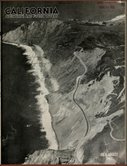
Hi June,
During the winter rains of 1950-51, the Devil’s Slide area had its third major closing. That time for 93 days, following closings of 47 days in both 1938 and 1942. While there wasn’t an article in the “Highways and Public Works” magazine describing the technical difficulties of its repairs, there was a cover page aerial photograph of it, post repairs, in the July-August 1951 issue. A short caption explained:
Sign Route 1 on Pedro Mountain in San Mateo County restored after last winter’s spectacular slide which required clearing of 900,000 cubic yards of slide material. (Aerial photo by M.R. Nickerson, Chief, Photographic Section, Department of Public Works.
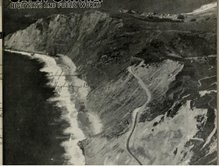
——————————
And enjoy “Crossing Devil’s Slide, 1970s,” a little movie made by June
1970s Silent Moovie: Crossing Devil’s Slide from June Morrall on Vimeo.
June Morrall: Let’s Meet at the El Granada Post Office
Story by June Morrall
On the Coastside, we who live in El Granada are lucky to have post office boxes. You can choose home delivery via the Half Moon Bay Route, but hardly anybody does, especially down here in the flatlands where I live. That’s because you can walk to the post office.
When folks move to El Granada, one of the first things they do is visit the post office to get a mailbox. It’s a “rite of passage,” an initiation, if you will. It’s got to be a unique experience for newcomers used to big city ways.
I can’t remember ever dreading the idea of going to the El Granada Post Office. Like: “OH NO! I have to go to the post office today.” Although the post office has moved from the north part of “town” to the south part of town, and in between, I’ve mostly walked there for nearly 40 years. Roundtrip, unless I go to the beach, it’s a 14- minute walk. Sure, sometimes I drive.
In El Granada (and, I bet it’s similar in Moss Beach and Montara, where the old Ocean Shore Railroad beach towns still retain their individuality), the post office is the center of our community. We don’t have a main street but we do have the post office. That’s where, even if you are a hardened hermit, you will run into friends you haven’t seen for years, who bring a smile to your face— as well as folks you may not now know, but I predict you will know in the future.
It’s the place where politicians [gently] hustle for votes, where local activists ask for signatures on petitions and organizations want you to buy their raffle tickets. It’s the place where the Bach Dancing & Dynamite Society’s Pete Douglas will hand you a music program and tell you, you’ve got to come to the next live show. I’ve never witnessed a “hard sell” in this soft-hearted town. But on many days, these kinds of things may not be your cup of tea (and, we’re all grateful that we have the option of slinking in and out of the post office, and there’s an “art” to that)— but remember the politicians, the activists, the raffle people— the friends or neighbors you haven’t seen in years—are all local. The faces are familiar. And isn’t that reassuring in a broader world that isn’t?
Is that a Peace Sign Over Pillar Point Harbor?
Can you see it? On the this side of the point? On the brown part?
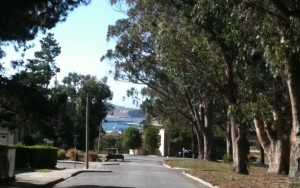
Joel Bratman: Travel Vicariously…..to Yosemite
John Vonderlin: Why Shipwrecks? Yep, it’s the fog
Story by John Vonderlin
Email John: [email protected]
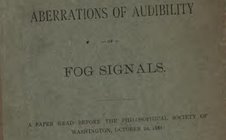
Artist Susan Friedman: On Wings & Hooves….Oct 31-Nov 31..Hunters Point Shipyards
Oct. 31 – Nov. 31 Hunter’s Point Shipyards
Come see artist/photographer/filmmaker Susan Friedman’s latest work: Wings & Hooves
(and her new book: “Drinkers of the Wind”)
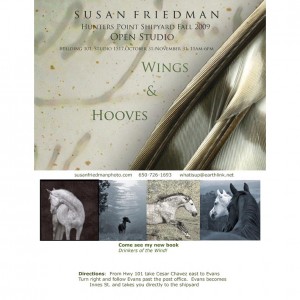
Email Susan: susanfriedmanphoto.com & [email protected]
Kai Tiura: Paintings by Mom Tiura & Galen Wolf
Kai Tiura says:

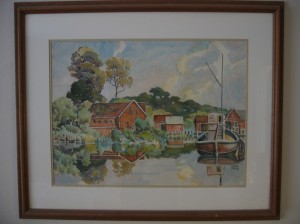
John Vonderlin & I want to know: What’s the name of the promontory in the foreground?
If there isn’t a name, can we name it?
Asks John Vonderlin: Do you recognize the coastal stretch in the picture? I assume the far promontory is the one just south of Devil’s Slide, but don’t know the name of the nearer one. Enjoy. John
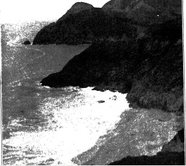
The image comes from J. Smeaton Chase’s  1911 book, “California Coast Trails.”
1911 book, “California Coast Trails.”
June says: I told John I didn’t the know name of it–but that a Texas oilman had plans to build a house, incorporating the WWII bunker, into the design–but that was in the 1970s and never came to pass.
John says: It might already have a name, Devil’s Slide Rock.
Email John: [email protected]
Email June: [email protected]
swanngalleries.com: 1921: For the Zoo (Artist: Charles Paine)
For more info on this 1921 color lithograph poster by artist Charles Paine : please visit Swanngalleries.com



